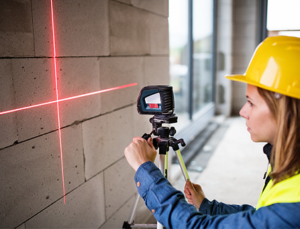
Drawing levels over long distances once used to necessitate the use of an automatic construction scope or optical level. The problem is that this device required the use of two people, with one manning the telescope and the other guiding the sight.
With a laser level, however, only one person is required to draw accurate levels on a construction site. Due to the reduction in labour costs, the laser level has become an industry-standard and indispensable tool for millions of construction workers across the globe.
Not only do they help keep things level and symmetrical but they can also be used for a variety of other surveying tasks. But with so many options to choose from, what kind of laser is going to do the job? Let’s start by exploring a few of the more common varieties of laser level.
Types of laser level
Line lasers – These are the most common and simple line levels and project horizontal or vertical lines onto a surface either through forward projection or 360-degree projection. These lasers are used most often when installing furniture or for more basic levelling tasks.
Spot lasers – A spot laser projects, as the name suggests, a dot onto the surface the laser is focused at. This is ideal for ensuring joists or piping has level and is often used by plumbers. Lasers typically generate either 3 or 5 spots from a central point.
Combination lasers – These lasers levels use both lines and spots and are perhaps the best choice for professional contractors who need to be able to switch between lines and spots to suit the job at hand. Electricians, for example, will find combination lasers incredibly useful.
Rotary lasers – Often used at the very start of a construction project to map out the “lay of the land,” so to speak, rotary lasers move laser lines along an x and y axis to draw out a space. They are ideal for digging foundations.
Red or green?
Most laser levels either come with green or red beams. Generally speaking, green laser levels are more visible than red laser levels and have a greater range. The more visible a beam, the better the job will be. It is worth noting, however, that green laser levels are more expensive than their red counterparts.
Indoor or outdoor?
Generally speaking, for outdoor use, you should always opt for a rotary laser. For mixed use, meanwhile, rotary or line laser levels should be used. For indoor use, any type of line, point or rotary laser level can be used. Note, however, that when working under bright daylight conditions the visibility of the beams will be reduced, particularly if you’re using a red laser level.


















